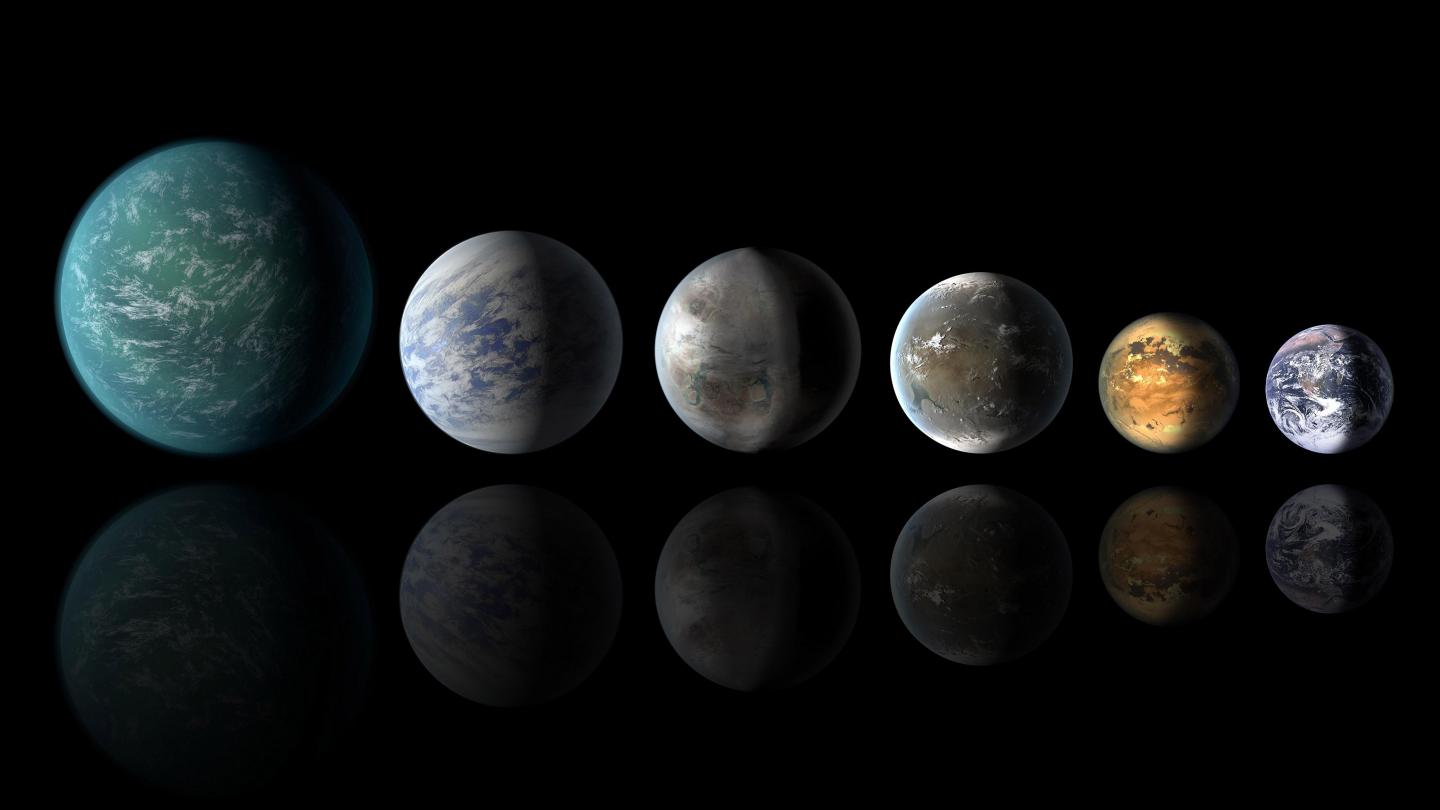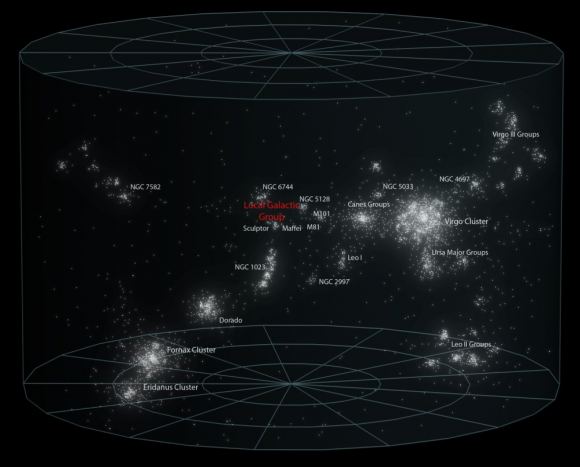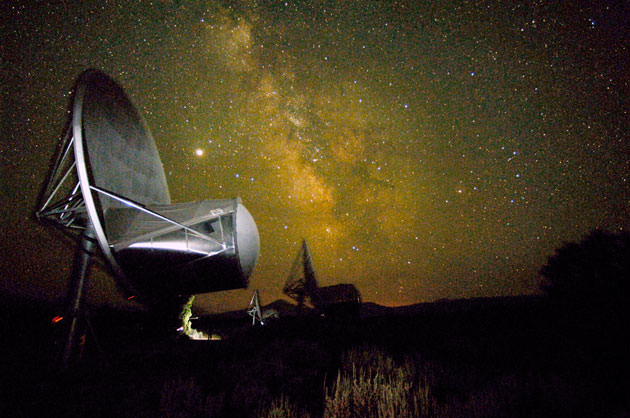This week, the non-profit research organization Breakthrough Listen announced that it was entering into a partnership with scientists from the NASA Transiting Exoplanet Survey Satellite (TESS) mission. This new collaboration will direct the resources of the former with data and expertise of the latter to the search for extra-terrestrial intelligence (SETI) like never before!
Continue reading “Breakthrough Listen and NASA Team Up to Look for Signs of Extra-Terrestrial Intelligence!”Fraser and John Michael Godier Debate the Fermi Paradox

As many of you are no doubt aware, our noble publisher, Fraser Cain, occasionally has the opportunity to sit down with some fellow great minds and discussion/debate issues that are relevant to space, exploration, and astronomy today. Most recently, this included an extended debate with noted author, futurists and Youtube sensation John Michael Godier.
The subject of this debate was the unresolved mystery that keeps more than a few astrophysicists awake at night. This is none other than the Fermi Paradox, the question that asks “Where are they?”
Want to Find Aliens? The Largest Dataset in the History of SETI has Been Released to the Public
In 2016, Russian-Israeli billionaire Yuri Milner launched Breakthrough Initiatives, a massive non-profit organization dedicated to the search for extra-terrestrial intelligence (SETI). A key part of their efforts to find evidence of intelligent life is Breakthrough Listen, a $100 million program that is currently conducting a survey of one million of the nearest stars and the 100 nearest galaxies.
In keeping with their commitment to making the results of their surveys available to the public, the Listen team recently submitted two papers to leading astrophysical journals. These papers describe the analysis of Listen’s first three years of radio observations which resulted in a petabyte of radio and optical data, the single largest release of SETI data in the history of the field.
Continue reading “Want to Find Aliens? The Largest Dataset in the History of SETI has Been Released to the Public”Advanced Civilizations Could be Communicating with Neutrino Beams. Transmitted by Clouds of Satellites Around Neutron Stars or Black Holes
In 1960, famed theoretical physicist Freeman Dyson made a radical proposal. In a paper titled “Search for Artificial Stellar Sources of Infrared Radiation” he suggested that advanced extra-terrestrial intelligences (ETIs) could be found by looking for signs of artificial structures so large, they encompassed entire star systems (aka. megastructures). Since then, many scientists have come up with their own ideas for possible megastructures.
Like Dyson’s proposed Sphere, these ideas were suggested as a way of giving scientists engaged in the Search for Extra-Terrestrial Intelligence (SETI) something to look for. Adding to this fascinating field, Dr. Albert Jackson of the Houston-based technology company Triton Systems recently released a study where he proposed how an advanced ETI could use rely on a neutron star or black hole to focus neutrino beams to create a beacon.
Continue reading “Advanced Civilizations Could be Communicating with Neutrino Beams. Transmitted by Clouds of Satellites Around Neutron Stars or Black Holes”Weekly Space Hangout: May 1, 2019 – Dr. Mark Showalter of SETI
Hosts:
Fraser Cain (universetoday.com / @fcain)
Dr. Pamela Gay (astronomycast.com / cosmoquest.org / @starstryder)
Dr. Kimberly Cartier (KimberlyCartier.org / @AstroKimCartier )
Dr. Morgan Rehnberg (MorganRehnberg.com / @MorganRehnberg & ChartYourWorld.org)
Dr. Paul M. Sutter (pmsutter.com / @PaulMattSutter)
Continue reading “Weekly Space Hangout: May 1, 2019 – Dr. Mark Showalter of SETI”
Maybe Self-Replicating Robot Probes are Destroying Each Other. That’s Why We Don’t See Them
During the 1940s, Hungarian-American scientist John von Neumann developed a mathematical theory for how machines could endlessly reproduce themselves. This work gave rise to the idea of “von Neumann probes“, a class of self-replicating interstellar probes (SRPs) that could be used to do everything from exploring the Universe to seeding it with life and intervening in species evolution.
Some have naturally suggested that this be a focus of SETI research, which would entail looking for signs of self-replicating spacecraft in our galaxy. But as is always the case with proposals like these, the Fermi Paradox eventually reasserts itself by asking the age-old question – “Where is everybody?” If there are alien civilizations out there, why haven’t we found any evidence of their SRPs?
Continue reading “Maybe Self-Replicating Robot Probes are Destroying Each Other. That’s Why We Don’t See Them”Gamma Ray Telescopes could Detect Starships Powered by Black Hole

In the course of looking for possible signs of Extra-Terrestrial Intelligence (ETI), scientists have had to do some really outside-of-the-box thinking. Since it is a foregone conclusion that many ETIs would be older and more technologically advanced than humanity, those engaged in the Search for Extra-Terrestrial Intelligence (SETI) have to consider what a more advanced species would be doing.
A particularly radical idea that has been suggested is that spacefaring civilizations could harness radiation emitted from black holes (Hawking radiation) to generate power. Building on this, Louis Crane – a mathematician from Kansas State University (KSU) – recently authored a study that suggests how surveys using gamma telescopes could find evidence of spacecraft powered by tiny artificial black holes.
Continue reading “Gamma Ray Telescopes could Detect Starships Powered by Black Hole”NASA’s Technosignatures Report is Out. Every Way to Find Evidence of an Intelligent Civilization

In 1961, famed astronomer Frank Drake created a formula for estimating the number of extra-terrestrial intelligences (ETIs) that could exist within our galaxy. Known as the “Drake Equation“, this formula demonstrated that even by the most conservative estimates, our galaxy was likely to host at least a few advanced civilizations at any given time. About a decade later, NASA officially kicked of its search for extra-terrestrial intelligence (SETI) program.
These efforts have experienced a major infusion of interest in recent decades thanks to the discovery of thousands of extrasolar planets. To address the possibility that life may exist out there, scientists are also relying on sophisticated tools to search for telltale indicators of biological processes (aka. biosignatures) and technological activity (technosignatures), which could indicate not only life but advanced intelligence.
Exoplanets Will Need Both Continents and Oceans to Form Complex Life

When it comes to the search for extra-terrestrial life, scientists have a tendency to be a bit geocentric – i.e. they look for planets that resemble our own. This is understandable, seeing as how Earth is the only planet that we know of that supports life. As result, those searching for extra-terrestrial life have been looking for planets that are terrestrial (rocky) in nature, orbit within their stars habitable zones, and have enough water on their surfaces.
In the course of discovering several thousand exoplanets, scientists have found that many may in fact be “water worlds” (planets where up to 50% of their mass is water). This naturally raises some questions, like how much water is too much, and could too much land be a problem as well? To address these, a pair of researchers from the Harvard Smithsonian Center for Astrophysics (CfA) conducted a study to determine how the ratio between water and land masses can contribute to life.
Continue reading “Exoplanets Will Need Both Continents and Oceans to Form Complex Life”
The Tools Humanity Will Need for Living in the Year 1 Trillion

Since the 1990s, astrophysicists have known that for the past few billion years, the Universe has been experiencing an accelerated rate of expansion. This gave rise to the theory that the Universe is permeated by a mysterious invisible energy known as “dark energy”, which acts against gravity and is pushing the cosmos apart. In time, this energy will become the dominant force in the Universe, causing all stars and galaxies to spread beyond the cosmic horizon.
At this point, all stars and galaxies in the Universe will no longer be visible or accessible from any other. The question remains, what will intelligent civilizations (such as our own) do for resources and energy at this point? This question was addressed in a recent paper by Dr. Abraham Loeb – the Frank B. Baird, Jr., Professor of Science at Harvard University and the Chair of the Harvard Astronomy Department.
The paper, “Securing Fuel for our Frigid Cosmic Future“, recently appeared online. As he indicates in his study, when the Universe is ten times its current age (roughly 138 billion years old), all stars outside the Local Group of galaxies will no be accessible to us since they will be receding away faster than the speed of light. For this reason, he recommends that humanity follow the lesson from Aesop’s fable, “The Ants and the Grasshopper”.
This classic tale tells the story of ants who spent the summer collecting food for the winter while the grasshopper chose to enjoy himself. While different versions of the story exist that offer different takes on the importance of hard work, charity, and compassion, the lesson is simple: always be prepared. In this respect, Loeb recommends that advanced species migrate to rich clusters of galaxies.
These clusters represent the largest reservoirs of matter bound by gravity and would therefore be better able to resist the accelerated expansion of the Universe. As Dr. Loeb told Universe Today via email:
“In my essay I point out that mother Nature was kind to us as it spontaneously gave birth to the same massive reservoir of fuel that we would have aspired to collect by artificial means. Primordial density perturbations from the early universe led to the gravitational collapse of regions as large as tens of millions of light years, assembling all the matter in them into clusters of galaxies – each containing the equivalent of a thousand Milky Way galaxies.”
Dr. Loeb also indicated where humanity (or other advanced civilizations) should consider relocating to when the expansion of the Universe causes the stars of the Local Group to expand beyond the cosmic horizon. Within 50 million light years, he indicates, likes the Virgo Cluster, which contains about a thousands times more matter than the Milky Way Galaxy. The second closest is the Coma Cluster, a collection of over 1000 galaxies located about 336 million light years away.

In addition to offering a solution to the accelerating expansion of the Universe, Dr. Loeb’s study also presents some interesting possibilities when it comes to the search for extra-terrestrial intelligence (SETI). If, in fact, there are already advanced civilizations migrating to prepare for the inevitable expansion of the Universe, they may be detectable by various means. As Dr. Loeb explained:
“If traveling civilizations transmit powerful signals then we might be able to see evidence for their migration towards clusters of galaxies. Moreover, we would expected a larger concentration of advanced civilization in clusters than would be expected simply by counting the number of galaxies there. Those that settle there could establish more prosperous communities, in analogy to civilizations near rivers or lakes on Earth.”
This paper is similar to a study Dr. Loeb conducted back in 2011, which appeared in the Journal of Cosmology and Astroparticle Physics under the title “Cosmology with Hypervelocity Stars“. At the time, Dr. Loeb was addressing what would happen in the distant future when all extragalactic light sources will cease to be visible or accessible due to the accelerating expansion of the Universe.
This study was a follow-up to a 2001 paper in which Dr. Loeb addressed what would become of the Universe in billions of years – which appeared in the journal Physical Review Letters under the title “The Long–Term Future of Extragalactic Astronomy“. Shortly thereafter, Dr. Loeb and Freeman Dyson himself began to correspond about what could be done to address this problem.

Their correspondence was the subject of an article by Nathan Sanders (a writer for Astrobites) who recounted what Dr. Loeb and Dr. Dyson had to say on the matter. As Dr. Loeb recalls:
“A decade ago I wrote a few papers on the long-term future of the Universe, trillions of years from now. Since the cosmic expansion is accelerating, I showed that once the universe will age by a factor of ten (about a hundred billion years from now), all matter outside our Local Group of galaxies (which includes the Milky Way and the Andromeda galaxy, along with their satellites) will be receding away from us faster than light. After one of my papers was posted in 2011, Freeman Dyson wrote to me and suggested to a vast “cosmic engineering project” in which we will concentrate matter from a large-scale region around us to a small enough volume such that it will stay bound by its own gravity and not expand with the rest of the Universe.”
At the time, Dr. Loeb indicated that data gathered by the Sloan Digital Sky Survey (SDSS) indicated that attempts at “super-engineering” did not appear to be taking place. This was based on the fact that the galaxy clusters observed by the SDSS were not overdense, nor did they exhibit particularly high velocities (as would be expected). To this, Dr. Dyson wrote: “That is disappointing. On the other hand, if our colleagues have been too lazy to do the job, we have plenty of time to start doing it ourselves.”
A similar idea was presented in a recent paper by Dr. Dan Hooper, an astrophysicist from the Fermi National Accelerator Laboratory (FNAL) and the University of Chicago. In his study, Dr. Hooper suggested that advanced species could survive all stars in the Local Group expanding beyond the cosmic horizon (100 billion years from now), by harvesting stars across tens of millions of light years.

This harvesting would consist of building unconventional Dyson Spheres that would use the energy they collected from stars to propel them towards the center of the species’ civilization. However, only stars that range in mass of 0.2 to 1 Solar Masses would be usable, as high-mass stars would evolve beyond their main sequence before reaching the destination and low-mass stars would not generate enough energy for acceleration to make it in time.
But as Dr. Loeb indicates, there are additional limitations to this approach, which makes migrating more attractive than harvesting.
“First, we do not know of any technology that enables moving stars around, and moreover Sun-like stars only shine for about ten billion years (of order the current age of the Universe) and cannot serve as nuclear furnaces that would keep us warm into the very distant future. Therefore, an advanced civilization does not need to embark on a giant construction project as suggested by Dyson and Hooper, but only needs to propel itself towards the nearest galaxy cluster and take advantage of the cluster resources as fuel for its future prosperity.”
While this may seem like a truly far-off concern, it does raise some interesting questions about the long-term evolution of the Universe and how intelligent civilizations may be forced to adapt. In the meantime, if it offers some additional possibilities for searching for extra-terrestrial intelligences (ETIs), then so much the better.
And as Dr. Dyson said, if there are currently no ETIs preparing for the coming “cosmic winter” with cosmic engineering projects, perhaps it is something humanity can plan to tackle someday!
Further Reading: arXiv, Journal of Cosmology and Astroparticle Physics, astrobites, astrobites (2)




